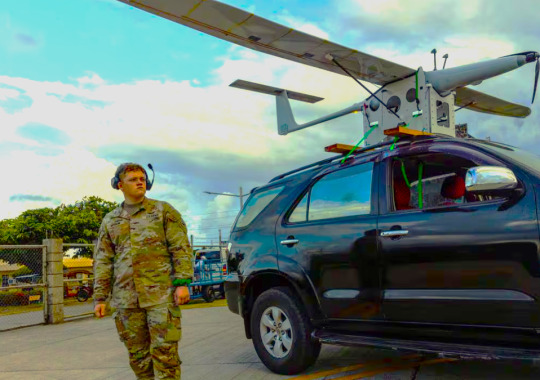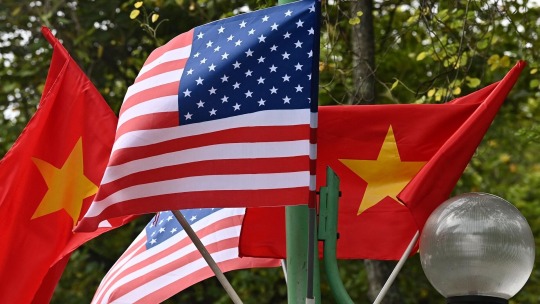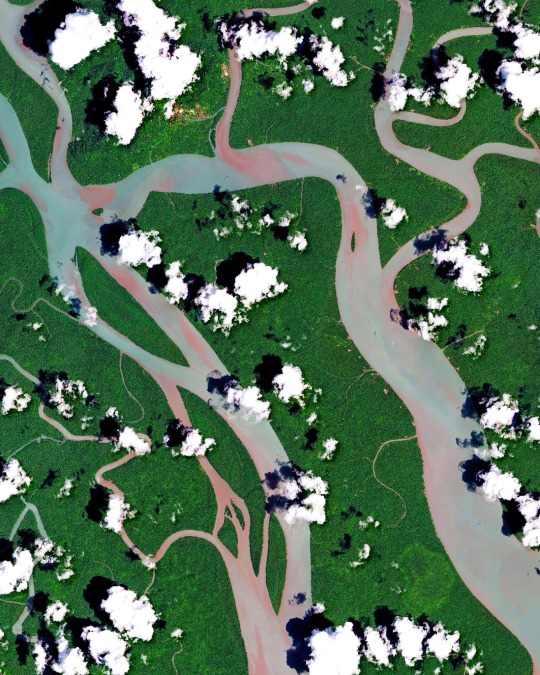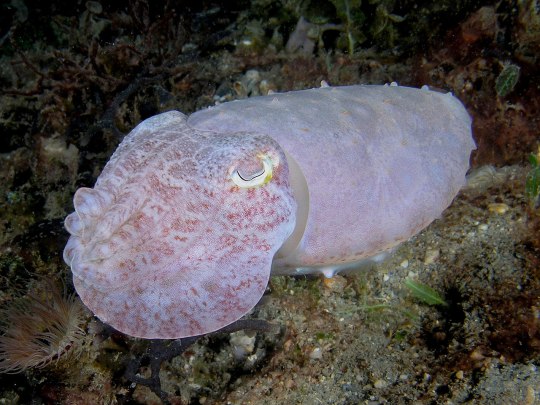#Indo-Pacific Region
Explore tagged Tumblr posts
Text

Crown-of-thorns starfish (Acanthaster planci)
Crown-of-thorns starfish are found on reefs in the Indo-Pacific region.
(Image credit: Georgette Douwma via Getty Images)
#georgette douwma#photographer#getty images#crown-of-thorns starfish#starfish#marine#acanthaster planci#indo-pacific region#reefs#nature
62 notes
·
View notes
Text
youtube
#youtube#militarytraining#National Security#Leadership#International Relations#Strategy#Diplomacy#Military#Symposium#Senior Leaders#US Navy#US Army#Security#US Military#US Air Force#Indo-Pacific Strategy#US Coast Guard#Global Affairs#US Marines#Indo-Pacific Region#Defense#Marine Corps#Panel Discussions#Partnership#Seoul#South Korea#Peace#USMC#Alliance#Marines
0 notes
Text
US Army Tests Long-Endurance Drones and Balloons in the Philippines: Pushing Boundaries in Multi-Domain Operations

The US Army is actively exploring the potential of long-endurance drones and high-altitude balloons in the Indo-Pacific region. During the recent Balikatan military exercise in the Philippines (April 11-May 9, 2024), the 1st Multi-Domain Task Force (MDTF) utilized these innovative technologies to gather valuable data and experiment with their tactical applications.
#Long-endurance drones#Balikatan military exercise#Indo-Pacific region#Unmanned Aircraft Systems (UAS)#K1000 drone#High-altitude balloons#US Army drones Philippines#Multi-Domain Task Force (MDTF)#ERSE#drone#drones uav#military#military aircraft#military technology
0 notes
Text
[Paper] The Beaked Adze in the Western Pacific
Discover the role of beaked adzes in Pacific prehistory: symbols of status in Micronesia and dual-purpose tools in Melanesia.
via Journal of Indo-Pacific Archaeology, 22 December 2023: The beaked adze, a distinctive tool with a pointed cutting edge, emerges as a significant artifact in the late prehistoric period of the Western Pacific. Recent studies highlight its unique presence in Micronesia and Melanesia, underscoring its role as a symbol of social identity and authority. In Micronesia, these adzes are associated…

View On WordPress
#ethnoarchaeology / ethnography / ethnology#Journal of Indo-Pacific Archaeology#lithics#Melanesia#Micronesia (region)#research papers
1 note
·
View note
Text
Exploring India and West Asia Relations
Delhi Policy Group provides in-depth analysis on the evolving relationship between India and West Asia. As the geopolitical landscape shifts, the organization examines the economic, political, and security dynamics shaping these crucial ties. From energy partnerships to regional security, Delhi Policy Group offers strategic insights to help policymakers navigate complex challenges. Through research and expert commentary, the organization contributes to a deeper understanding of how India and West Asia can collaborate to address shared interests and strengthen their regional and global positions.
0 notes
Text
India: The Emerging Global Hub for Manufacturing, Maintenance, and Logistics
Imagine a world where India isn’t just the land of vibrant cultures, ancient history, and spicy curry but also the backbone of global manufacturing, maintenance, and logistics. This vision is rapidly becoming a reality, transforming India’s role in the global economy and military alliances. As this transformation unfolds, the implications are profound, setting the stage for India to become an…
#2024#aerospace industry#allied nations#armed forces#defense sector#digital transformation#diplomatic ties#economic development#economic growth#geopolitical significance#global hub#Global Supply Chain#India#Indo-Pacific#industrial corridors#infrastructure#international partnerships#Logistics#maintenance#Make in India#Manufacturing#maritime services#non-alignment#QUAD#regional-security#repairs#skilled labor#strategic location#Strategic-Alliances#technological advancements
0 notes
Text
Upgrade Alert: The Future of Indian Air Force Fighter Jets
What are your thoughts on the future of the Indian Air Force? Share your insights and questions in the comments below!
The Indian Air Force is famed for its skilled pilots and cutting-edge fighter jets. But with aging aircraft and a regional arms race, the IAF faces a turbulent future. This in-depth analysis explores their challenges, modernization efforts, and the roadmap for India’s airpower ambitions.-Kumar A. [[email protected]] When an IAF fighter jet goes down, the nation holds its breath. Recent…

View On WordPress
#fighter jets#Indian Air Force#Indo-Pacific#MiG-21#modernization#procurement#Rafale#regional rivalry#squadron strength#Tejas
0 notes
Text
Vietnam ‘Has No Interest’ in Joining ‘US-Orchestrated’ Anti-China Coalition

US and Vietnam national flags fly on a street light in Hanoi on September 10, 2023, ahead of US President Joe Biden's visit to Vietnam. Sputnik International, © AFP 2023/Nhac Nguyen
As part of an effort to woo Vietnam to serve its geopolitical interests, US President Joe Biden is arriving in Hanoi on Sunday, nurturing hopes of signing a “comprehensive strategic partnership agreement” with the dynamically developing Southeast Asian nation.
Washington is eyeing “swaying Vietnam to its side,” for it believes the US can use Hanoi as “a counterbalance to China’s influence in South East Asia,” Professor Anna Malindog-Uy, Vice President of the Manila-based think tank Asian Century Philippines Strategic Studies Institute (ACPh), told Sputnik.
However, there is no indication that Vietnam has any interest in joining the “US-orchestrated” coalition against China, consisting of Washington’s allies, Anna Malindog-Uy added.
US President Joe Biden’s meeting with Vietnamese General Secretary Nguyen Phu Trong and other key leaders in Hanoi on September 10 comes as part of the latest page in the US’ Indo-Pacific playbook. Suffice it to recall how Biden hosted Philippine President Ferdinand R. Marcos Jr. in Washington in May, then welcomed Indian Prime Minister Narendra Modi at the White House in June, and threw open the doors of his Camp David presidential retreat to his Japanese and South Korean counterparts mid-August.
The trilateral summit with South Korean President Yoon Suk-yeol and Japanese Prime Minister Fumio Kishida is regarded by pundits talking to Sputnik as part of an effort blatantly tailored to forge a new alliance against China and the People’s Democratic Republic of Korea (DPRK). The US has also been posturing in the Indo-Pacific region by holding a slew of large military drills with Japan, Australia, and the Philippines in the South China Sea in recent days.
Vietnam is vital to US foreign policy for several political, economic, and geopolitical reasons, the professor underscored. Firstly, the “strategic geographical location” of Vietnam in Southeast Asia (SEA) is important to the US. Vietnam boasts “close contiguity and nearness to major global shipping lines like the South China Sea (SCS), and it has a border with China,” Anna Malindog-Uy stressed.
Geopolitically Strategic Location
Vietnam plays a crucial role in US foreign policy due to its "strategic location, economic significance, and potential to counterbalance China," according to Professor Anna Malindog-Uy.
“American companies have invested in Vietnam, and trade relations have expanded. Since Vietnam is a member of ASEAN, a regional body that is important to the US, especially on issues such as economic integration, security, and diplomacy, this makes Vietnam a vital partner of the US in advancing its interests in the Indo-Pacific region. The US is likewise keen on upgrading its relations with Vietnam from a 'comprehensive partnership,' established in 2013, to a 'strategic' partnership.'"
Hanoi is being eyed by Washington for its perceived “potential to counterbalance China,” the expert added.
“The evolving relationship between the United States and Vietnam manifests the broader and active US engagement in the Asia-Pacific region and underscores Vietnam's growing importance as a regional partner,” Anna Malindog-Uy emphasized.
Vietnam became a focal point for US diplomacy when it became the sixth member of the Association of Southeast Asian Nations (ASEAN) in July 1995, the same month Vietnam and the United States normalized relations, concurred Carl Thayer, emeritus professor at the University of New South Wales Canberra at the Australian Defense Force Academy. Further along, Vietnam gradually emerged as a potential US security partner.
“The turning point came during President Barack Obama’s term in office when Vietnam and the US agreed in 2013 to a comprehensive partnership covering nine major areas of cooperation. Since that time, Vietnam has been identified as an important security partner in all US national security strategies, particularly because of China’s growing 'assertiveness,'” said Carl Thayer, adding that the US has been seeking to “counter the appeal” of China’s Belt and Road Initiative launched in 2013.
More recently, the Biden administration has “lobbied Vietnam to upgrade bilateral relations to a strategic partnership to end the situation where the US was listed at the bottom of Vietnam’s three-tiered hierarchy of partnerships – comprehensive, strategic and comprehensive strategic,” Thayer added.
Vietnam an ‘Important Trading Partner’
Vietnam has also emerged as an important trading partner for the US in recent years.
“As one of the fastest-growing economies of SEA, Vietnam is a market for US goods and services, especially in sectors like technology, manufacturing, agriculture, and services. Strengthening relations with Vietnam can give American businesses and exporters more economic opportunities, given Vietnam's rising middle class and a young, educated workforce with higher purchasing power. Since Vietnam is already a vital player in global manufacturing, particularly electronics, textiles, and machinery, US companies can benefit from diversifying their supply chains by investing in or partnering with Vietnamese firms,” the vice president of ACPh underscored.
Furthermore, Vietnam is part of several regional trade agreements, such as the Comprehensive and Progressive Agreement for Trans-Pacific Partnership (CPTPP), and the Regional Comprehensive Economic Partnership (RCEP) - the world’s largest free trade pact. The latter entered full force for all 15 member states following ratification of the pact by the Philippines in June. Thus, boosted ties with Vietnam could grant America more "reach" within these regional economic frameworks. Tourism, too, is fraught with benefits for the two nations.
It's worth noting that the United States is "not a party to the two most important multilateral free trade agreements," the CPTPP and the RCEP, to which Vietnam is a member, Carl Thayer pointed out.
Regarding the goals that the US president is pursuing in respect to Vietnam, he is “motivated mainly by economic issues such de-risking economic dependence on China by securing a reliable supply chain for Vietnamese semiconductors, and a more favorable environment for American investment, including American businesses relocating from China,” the professor said, adding:
“Biden hopes Vietnam will be a founding member of his Indo-Pacific Economic Framework for Prosperity.”
The US has been bolstering its presence in the Indo-Pacific region by forming alliances such as AUKUS, which groups the country with Australia and the UK, and the Quadrilateral Security Dialogue (QUAD) with Australia, India, and Japan. Washington is also part of the Indo-Pacific Economic Framework for Prosperity (IPEF) initiative, launched by Biden in May 2022 and now including 13 other members, such as Australia, Brunei, Fiji, India, Indonesia, Japan, Malaysia, and New Zealand.
'US-Orchestrated Coalition' Against China
While visiting US Treasury Secretary Janet Yellen recently hailed Vietnam as "a key partner" in an effort to reduce dependence on China, Hanoi is “careful not to take sides between the US and China,” Anna Malindog-Uy said. Furthermore, taking sides between the US and China would be “costly for Vietnam both geopolitically and economically speaking.”
“As far as the US-led global coalition against China is concerned, I don’t think Vietnam has the intention or interest to be part of this. I don’t see any indication that Vietnam will join the US-orchestrated and led global coalition against China consisting of US allies... From my vantage point, it [Vietnam] wants to maintain good relations with neighboring countries like China as much as possible. Vietnam knows that joining a US-led coalition against China could potentially adversely impact its economic relations with China, which is vital to Vietnam’s economic development and progress,” the pundit believes.
ASEAN-member Vietnam “values neutrality,” and “follows a policy of non-alignment in major power conflicts, competition, and rivalry,” the vice president of the Manila-based ACPh think tank accentuated.
While Washington has been escalating trade and tech wars with Beijing, Hanoi has been steadily maintaining a “stable, pragmatic, and productive win-win relationship and cooperation with China, its largest neighbor and trading and economic partner.” China is "indispensable to Vietnam's economic well-being," and is a crucial market for Vietnamese exports, "particularly in electronics, textiles, and agriculture sectors." China is also one of the top foreign investors in Vietnam, particularly when it comes to infrastructure development. Many Vietnamese industries are deeply integrated into Chinese supply chains.
“China is crucial to Vietnam due to its economic significance, shared border, historical ties, and geopolitical factors. Balancing its relationship with China with its relationships with other regional and global powers is a crucial feature of Vietnam's foreign policy,” the pundit highlighted. Bearing in mind the sum total of economic significance, shared border, historical ties, and geopolitical factors, Anna Malindog-Uy emphasized:
“I don’t think Vietnam will compromise its sound economic and political relations with China by joining a global US-led coalition.”
Carl Thayer agreed with this opinion, telling Sputnik:
"Vietnam will not abandon its 'Four No’s' defense policy (no alliances, no foreign military bases, no joining one country to oppose another, and no use of force in international relations). Vietnam will not join any US-led anti-China coalition."
Russia of 'Strategic Importance' for Vietnam
At this point it should be noted that Vietnam has comprehensive strategic partnerships with only four countries - China, Russia, India, and South Korea. The significance of both China and Russia for Vietnam cannot be overestimated, pundits have underscored. Russia bears strategic importance to Vietnam due to a historical relationship stretching all the way back to the Cold War era, Anna Malindog-Uy recalled. The professor clarified that Moscow plays a vital role in Hanoi's "strategic, defense, and security considerations," along with potential for energy collaboration.
Furthermore, Joe Biden’s "courting" of Vietnam comes as the Southeast Asian nation has been reluctant to support Western sanctions against Russia. This is due to a “complex interplay of historical ties, foreign policy principles, and national interests,” Professor Anna Malindog-Uy underscored. She added:
“During the Cold War, the Soviet Union provided significant support to North Vietnam during the Vietnam War. This created a foundation of goodwill between the two countries. Vietnam also has a close defense and military relationship with Russia. Russia is a key supplier of military equipment and technology for Vietnam, including fighter jets, submarines, and other advanced weaponry. This defense partnership is vital to Vietnam's security and defense capabilities. Russia and Vietnam also have relatively strong economic and trade ties, especially in machinery, textiles, and agricultural products.”
Supporting Western sanctions against Russia "could potentially harm Vietnam’s economic interests and disrupt ongoing economic cooperation," Anna Malindog-Uy pointed out.
Indeed, Vietnam has a longstanding policy of opposing the unilateral imposition of sanctions by one state against another, Carl Thayer added. He recalled that Hanoi has not forgotten the bitter fallout from the US trade embargo imposed in the 1960s during the Vietnam War. But furthermore, Vietnam is “also practical, it does not want to harm relations with a Russia, a long-standing reliable partner,” said Thayer.
— Svetlana Ekimenko | Sputnik International | September 10, 2023
#Analysis | Joe Biden | US 🇺🇸 | Vietnam 🇻🇳 | Indo-Pacific | Nguyen Phu Trong#Comprehensive and Progressive Agreement for Trans-Pacific Partnership (CPTPP)#Regional Comprehensive Economic Partnership (RCEP) China 🇨🇳 | Hanoi
0 notes
Text

Clouds float over the Kikori River Delta in southern Papua New Guinea. Part of the Gulf of Papua, this coastal mangrove forest is considered one of the most important wetland regions in the Asia-Pacific due to its cultural and biodiversity value. It is a habitat for Indo-Pacific humpback and Australian snubfin dolphins, both listed as “vulnerable” on the IUCN Red List of Threatened Species.
-7.428366°, 144.428927°
Source imagery: Airbus Space
893 notes
·
View notes
Text


Broadclub Cuttlefish (Sepia latimanus), family Sepiidae, found in the Indo-Pacific region
These images, of the same individual, were taken just seconds apart from each other.
photographs by Nick Hobgood
2K notes
·
View notes
Text

THAT'S A DOWNRIGHT LIE
THE SOURCES CITED ARE ABOUT HORNED GHOST CRABS. THEY'RE COMPLETELY DIFFERENT!!
GET RID OF AI IT'S FUCKING USELESS
GOLDEN GHOST CRABS DON'T LIVE IN THE INDO PACIFIC REGION.
THEY LIVE IN FUCKING AUSTRALIA
WHICH IM PRETTY SURE ISN'T IN THE INDO PACIFIC REGION
GET RID OF AI!!!!
250 notes
·
View notes
Text

Flamboyant cuttlefish
Another unappetizing cephalopod, the flamboyant cuttlefish (Metasepia pfefferi), can be found along shallow, muddy ocean bottoms in the Indo-Pacific region. Its flame-like coloration and frilly body shape provide an eye-catching warning against consumption.
(Image credit: Ullstein Bild / Contributor)
#ullstein bild#photographer#flamboyant cuttlefish#cuttlefish#cephalopod#metasepia pfefferi#indo-pacific region#nature
116 notes
·
View notes
Text
youtube
#youtube#militarytraining#Pacific Command#US Indo-Pacific Command#Lloyd J. Austin III#Indo-Pacific Command#Change of Command#Defense Minister#Leadership#Military#Speech#US Army#Security#Commander#Ceremony#Defense#Army General#Indo-Pacific Region#Army Chief#Military Ceremony#Asia-Pacific#US Military.#lloyd austin
0 notes
Text















Расписная каракатица (Metasepia Pfefferi) одна из удивительных представителей морской фауны живущая в теплых тропических водах Индо-Тихоокеанского региона. Ее можно встретить у берегов северной ��встралии, Южной Гвинеи, у островов Индонези, Малайзии и Филиппин. Небольшие расписные каракатицы своим необычным внешним видом и забавным передвижением по морскому дну, напоминают странствие маленьких слонов, с довольно красочной и пестрой расцветкой. Метасепий еще частенько называют морскими хамелеонами, из-за своей способности мгновенно менять свой цветной наряд. В покое она покрыта тёмно-коричневыми разводами, а во время угрозы его тело начинает интенсивно менять цвета и излучать неоновые переливы, а кончики щупалец краснеют. Этот сложный камуфляж управляется за счёт сжатия и расслабления хроматофоров. Причем происходит это так быстро, что человеческий глаз даже не способен увидеть все оттенки и промежуточные тона смены цветов. Ведь меняют они свой окрас за 300 миллисекунд, то есть за три десятых доли секунды. Расписные каракатицы являются любимыми объектами дайверов любителей пофотографировать этих удивительных морских представителей. Индонезийцы за сказочную красоту и способность менять свои оттенки называют этих моллюсков «ведром краски» .
Метасепии, не смотря на свой меленький размер, всего 6-8 сантиметров, довольно храбрые хищники. Даже в момент, когда им страшно они не покинут своей территории и будут до конца защищать свое облюбованное место обитания. Основную активность расписная каракатица проявляет днем. Все это время она проводит, укрывшись в засаде в ожидании чего-нибудь вкусненького. Этим вкусненьким чаще всего являются мелкая рыбешка и ракообразные.
Еще одной отличительной чертой этого вида каракатиц является их неспособность к плаванию. Передвигаются они только по дну, помогая себе взмахами широких мембран по бокам.
Расписные каракатицы — это один из трех известных ядовитых видов головоногих. Яд каракатиц оказывает аналогичные летальные последствия, что и токсин синекольчатого осьминога. Вещество это очень опасное для людей. Как выяснилось, Метасепия содержит яды и в тканях, и в слюне, и в слизи. Однако, если ее не трогать, то это не имеет особого значения. Укусить человека она не может, да и в пищу не годится.
Flamboyant cuttlefish (Metasepia Pfefferi) is one of the amazing representatives of marine fauna living in the warm tropical waters of the Indo-Pacific region. It can be found off the coast of northern Australia, South Guinea, the islands of Indonesia, Malaysia and the Philippines. Small flamboyant cuttlefish with their unusual appearance and funny movement along the seabed, resemble the wandering of small elephants, with a rather colorful and motley coloring. Metasepia is often called sea chameleons, because of their ability to instantly change their color outfit. At rest, it is covered with dark brown streaks, and when threatened, its body begins to intensively change colors and emit neon tints, and the tips of the tentacles turn red. This complex camouflage is controlled by the compression and relaxation of chromatophores. Moreover, this happens so quickly that the human eye is not even able to see all the shades and intermediate tones of color change. After all, they change their color in 300 milliseconds, that is, in three tenths of a second. Flamboyant cuttlefish are favorite objects of divers who like to photograph these amazing marine representatives. Indonesians call these mollusks a "bucket of paint" for their fabulous beauty and ability to change their shades.
Metasepias, despite their small size, only 6-8 centimeters, are quite brave predators. Even when they are scared, they will not leave their territory and will defend their favorite habitat to the end. The Flamboyant cuttlefish is most active during the day. All this time it spends, hiding in ambush, waiting for something tasty. This tasty treat is most often small fish and crustaceans.
Another distinctive feature of this type of cuttlefish is their inability to swim. They move only along the bottom, helping themselves with the strokes of wide membranes on the sides.
Flamboyant cuttlefish are one of three known poisonous species of cephalopods. The cuttlefish venom has similar lethal effects as the blue-ringed octopus toxin. This substance is very dangerous to humans. As it turns out, Metasepia contains poisons in its tissues, saliva, and mucus. However, if you leave it alone, this does not matter much. It cannot bite a person, and it is not suitable for food.
Источник://t.me/+E4YBiErj0A8wOGUy/allfreefoto.com/tsvetistaya-karakatitsa.html, /ianimal.ru / topics/raspisnaya-karakatica, //antimantikora.livejournal. com/ 1121474.html, //vk.com/wall-89846550_136187.
#video#animal video#marine life#marine biology#nature#aquatic animals#cephalopods#cuttlefish#Metasepia Pfefferi#underwater#ocean#seaweed#sand#animal photography#nature aesthetic#видео#фауна#Головоногие#каракатица#Расписная каракатица#природа#океан#водоросли#песок#природнаякрасота
185 notes
·
View notes
Text
In Honor of National Crab Day, Behold the Candy Crab 🦀 🦀 🦀!









The candy crab (Hoplophrys oatesi) is a small but stunning crustacean that lives on soft corals in the Indo-Pacific region
It hides itself by mimicking the colors of the coral it takes refuge in. The candy crab will even attach polyps to its carapace for added camouflage
Their colors vary depending on the color of the coral they hide in so they can be white, pink, yellow or red
Love to sea it 🌊
#crab day#marine biology#marine science#science#biology#crabs#crab#crustacean nation#crustacean#national crab day#candy crab#marine life#oceanography#love to sea it#marine creatures#ocean life#sea animals#sea creatures#naturecore#sea critters#ocean animals#sea life#marine animals#ocean#crablr#aquatic life#underwater#ocean creatures#crustaceans#photography
208 notes
·
View notes
Text
Addressing India’s Security Challenges
The Delhi Policy Group delves into India’s security challenges, offering expert analysis and strategic insights. From border disputes to internal conflicts, our research explores the complex issues impacting national security. By understanding these challenges, we aim to contribute to informed policy-making and effective solutions.
0 notes